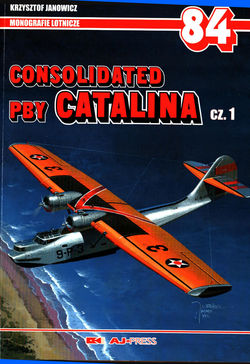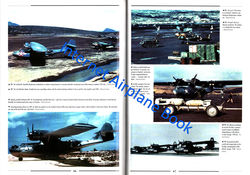AJ
PRESS 84 CONSOLIDATED PBY CATALINA FLYING BOAT WW2 USN VP USAAF OA-10 USCG RAF RNZAF
PBN-1 RUSSIA ARS
SOFTBOUND BOOK in POLISH (with ENGLISH
PHOTO CAPTIONS) by KRZYSZTOF JANOWICZ
DEVELOPMENTAL HISTORY (CONSOLIDATED
XP3Y-1 PROTOTYPE, PBY-1, PBY-2, RAF, RCAF CANSO, FRENCH NAVY AERONAVALE, PBY-5,
PBY-5A AMPHIBIAN, PBY-6A, NAVAL AIRCRAFT FACTORY PBN-1 NOMAD, PACIFIC BLACK
CATS, BATTLE OF THE ATLANTIC, USAAF OA-10A AIR SEA RESCUE ASR – EMERGENCY
RESCUE SQUADRON, ANCESTORS, FIRST CONSOLIDATED
AIRCRAFT PBY, SUBSEQUENT PBY MODELS, LIFE EXTENSION, PATROL AVIATION
DEVELOPMENT USN VP, SAN DIEGO PRODUCTION, CONSOLIDATED VULTEE PRODUCTION NEW
ORLEANS)
CONSOLIDATED XPY-1 MONOPLANE FLYING
BOAT
P2Y
XP3Y-1 & XPBY-1 PROTOTYPES
XP3Y-1 DETAIL PHOTOGRAPH GALLERY
PRODUCTION VARIANTS (PBY-1, 1935, 1936)
PBY-1 DETAILS (BOW TURRET, BOMBARDIERfS
COMPARTMENT, ANCHOR COMPARTMENT, INTERIOR DETAILS, WAIST GUN DETAILS, LIVING
QUARTERS, TUNNEL GUN, WING TIP FLOATS & BEACHING GEAR, PRATT & WHITNEY
R-1830-64 ENGINES, OFFENSIVE ARMAMENT – BOMB RACKS)
PBY-2 FLYING BOAT (PRATT & WHITNEY F-1830-64 ENGINE
DETAIL,
PBY-3 FLYING BOAT (CARBURETOR AIR INTAKE / EXHAUST STACK
DETAIL, WING
TORPEDO MOUNTS, HOISTS, INTERIOR DETAILS)
PBY-4 FLYING BOAT (PROPELLER HUB-SPINNER DEVELOPMENT
DETAIL, AMERICAN EXPORT AIRLINES TRANSATLANTIC SERVICE, P-9630 COMMERCIAL
VARIANT)
PBY-5 CATALINA FLYING BOAT (WAIST GUNNER POSITION DETAIL,
ENGINE DEVELOPMENT: PRATT & WHTINEY R-1830-72 & R-1830-82, TAIL
DEVELOPMENT, DF LOOP DEVELOPMENT, COCKPIT,
RADIO OPERATOR STATION, NAVIGATOR STATION, MECHANICfS STATION, LIVING QUARTERS
& WAIST GUN, LANDING GEAR DETAILS, R-1830-92 ENGINE DETAILS)
PBY-5A AMPHIBIAN (UNITED STATES COAST
GUARD USCG, COCKPIT DETAILS, BOW TURRET, RADIO OPERATOR & NAVIGATOR
COMPARTMENT, WAIST GUN INSTALLATION & BLISTERS, OFFENSIVE ARMAMENT,
FUSELAGE DETAILS, ENGINE DETAILS, WING DETAILS, RADAR INSTALLATIONS, TUNNEL
GUN, MAD EQUIPMENT, TAIL DETAILS)
PBY-5B
PBN-1 NOMAD (DETAIL DIFFERENCES)
PBY-6A
USAAF OA-10
PRELUDE TO WAR (OCCUPATION OF GREENLAND AND ICELAND,
NEUTRALITY PATROLS, PEARL HARBOR)
WESTERN ATLANTIC (KEY WEST, PANAMA CANAL ZONE, QUONSET
POINT RHODE ISLAND, NAS NORFOLK, JACKSONVILLE, CARRIBEBEAN & THE GULF OF
MEXICO, ATTACKS IN THE GULF OF MEXICO, PENSACOLA, CUBA, HAITI, PBYfs REPLACED
BY MARTIN PBM MARINER)
NORTH ATLANTIC (LITTLE PLACENTIA BAY ARGENTIA
NEWFOUNDLAND CANADA, EARLY GREENLAND OPERATIONS, CAMP KWITCHERBELLIAKIN
REYKJAVIK ICELAND, CONVOY COVER, VP-84 JOINS THE BATTLE, THE BLOODY WINTER OF
1943, TRIUMPH OVER THE U-BOAT WOLFPACKS)
SOUTH ATLANTIC (NATAL BRAZIL)
EASTERN ATLANTIC (CASABLANCA, AGADIR, VP-63 MAD CATS,
GIBRALTER, PORT LYAUTEY, FRENCH SQUADRONS NORTH AFRICA)
SEARCH AND RESCUE
RETRACTING WING TIP STABILIZER FLOAT DETAIL, PBY UNDER WING BOMB RACK
DETAIL, BEACHING GEAR DETAIL, PRATT & WHITNEY F-1830-64 ENGINE DETAIL,
CARBURETOR AIR INTAKE / EXHAUST STACK DETAIL, PROPELLER HUB-SPINNER DEVELOPMENT
DETAIL, WAIST GUNNER POSITION DETAIL, ENGINE DEVELOPMENT: PRATT & WHTINEY
R-1830-72 & R-1830-82, TAIL DEVELOPMENT, DF LOOP DEVELOPMENT)
GENERAL SPECIFICATIONS
CREW
ARMOR
DEFENSIVE ARMAMENT
PRATT & WHITNEY R-1830 TWIN WASP
HAMILTON STANDARD HYDROMATIC PROPELLERS
COLOR PROFILES
ROYAL NAVY CATALINA I & CATALINA II
PBY-5A CATALINA AMPHIBIAN (RADIO ANTENNA DETAILS, IFF, LORENZ & ASV
ANTENNA INSTALLATION, PORT WAIST GUN BLISTER DETAIL, BOW TURRET DEVELOPMENT)
PBY-6A AMPHIBIAN
US NAVY PBY OPERATIONS (PRE-WORLD WAR II, WORLD WAR II, TUNNEL GUN FUSELAGE
BLISTER DETAIL, TORPEDO ATTACKS, BLACK CATS, DUMBO RESCUE MISSIONS)
POST-WAR OPERATIONS (US NAVY, FOREIGN SERVICES, CIVIL SERVICE)
-----------------------------------------------------------------------------------------------------
Additional Information from Internet Encyclopedia
The Consolidated PBY Catalina was an
American flying boat, and later an amphibious aircraft of the 1930s and 1940s
produced by Consolidated Aircraft. It was one of the most widely used seaplanes
of World War II. Catalinas served with every branch of the United States Armed
Forces and in the air forces and navies of many other nations.
During World War
II, PBYs were used in anti-submarine warfare, patrol bombing, convoy escorts,
search and rescue missions (especially air-sea rescue), and cargo transport.
The PBY was the most numerous aircraft of its kind and the last active military
PBYs were not retired from service until the 1980s. Even today, nearly 80 years
after its first flight, the aircraft continues to fly as a waterbomber (or
airtanker) in aerial firefighting operations all over the world.
The designation
"PBY" was determined in accordance with the U.S. Navy aircraft
designation system of 1922; PB
representing "Patrol Bomber" and Y being the code assigned to Consolidated Aircraft as its
manufacturer. Catalinas built by other manufacturers for the US Navy were
designated according to different manufacturer codes, thus Canadian
Vickers-built examples were designated PBV,
Boeing-Canada examples PB2B
(there already being a Boeing PBB) and Naval Aircraft Factory examples were
designated PBN. Canadian
examples were named Canso by the
Royal Canadian Air Force. The United States Army Air Forces and later the
United States Air Force used the designation OA-10.
Although slow and
ungainly, Catalinas distinguished themselves in World War II. Allied forces
used them successfully in a wide variety of roles that the aircraft was never
intended for. They are remembered for their role in rescuing downed airmen, in
which they saved the lives of thousands of aircrew downed over water. Catalina
airmen called their aircraft the "cat" on combat missions and
"Dumbo" in air-sea rescue serviceNavy Catalinas used in the Pacific
against the Japanese for night operations were painted black overall, and as a
result were sometimes referred to locally as "Black Cats". In
their role as patrol aircraft, Catalinas participated in some of the most
notable naval engagements of World War II. The aircraft's parasol wing and
large waist blisters provided excellent visibility and combined with its long
range and endurance, made it well suited for the task.
The Naval Aircraft
Factory made significant modifications to the PBY design, many of which would
have significantly interrupted deliveries had they been incorporated on the
Consolidated production lines. The new aircraft, officially known as the PBN-1 Nomad, had several differences
from the basic PBY. The most obvious upgrades were to the bow, which was
sharpened and extended by two feet, and to the tail, which was enlarged and
featured a new shape. Other improvements included larger fuel tanks, increasing
range by 50%, and stronger wings permitting a 2,000 lb (908 kg)
increase in gross takeoff weight. An auxiliary power unit was installed, along
with an improved electrical system, and the weapons were upgraded with
continuous-feed mechanisms.
138 of the 156 PBN-1s
produced served with the Soviet Navy. The remaining 18 were assigned to
training units at NAS Whidbey Island and the Naval Air Facility in Newport,
Rhode Island. Later, improvements found in the PBN such as the larger tail were
incorporated into the amphibious PBY-6A.
Catalinas were the
most extensively used ASW aircraft in both the Atlantic and Pacific Theaters of
the Second World War, and were also used in the Indian Ocean, flying from the
Seychelles and from Ceylon. Their duties included escorting convoys to
Murmansk. By 1943, U-boats were well-armed with anti-aircraft guns and two
Victoria Crosses were won by Catalina pilots pressing home their attacks on
U-boats in the face of heavy fire.
An RAF Coastal
Command Catalina located the German battleship Bismarck, which was attempting to evade Royal Navy forces
eventually leading to the destruction of the German battleship.
A flight of
Catalinas spotted the Japanese fleet approaching Midway Island, beginning the
Battle of Midway.
Several squadrons
of PBY-5As and -6As in the Pacific theater were specially modified to operate
as night raiders. Outfitted with state-of-the-art magnetic anomaly detectors
and painted flat black, these "Black Cats" attacked Japanese supply
convoys at night. Catalinas were surprisingly successful and from August 1943
to January 1944, Black Cats sank 112,700 tons of merchant shipping, damaged
47,000 tons, and damaged 10 Japanese warships.
The Royal Australian Air Force (RAAF) also operated
Catalinas as night raiders, with four squadrons Nos. 11, 20, 42, and 43 laying
mines from 23 April 1943 until July 1945 in the southwest Pacific deep in
Japanese-held waters, bottling up ports and shipping routes and forcing ships
into deeper waters to become targets for U.S. submarines; they tied up the
major strategic ports such as Balikpapan which shipped 80% of Japanese oil
supplies. In late 1944, their mining missions sometimes exceeded 20 hours in
duration and were carried out from as low as 200 ft (61 m) in the
dark. Operations included trapping the Japanese fleet in Manila Bay in
assistance of General Douglas MacArthur's landing at Mindoro in the
Philippines. Australian Catalinas also operated out of Jinamoc in the Leyte
Gulf, and mined ports on the Chinese coast from Hong Kong to as far north as
Wenchow. The RAAF Catalinas regularly mounted nuisance night bombing raids on
Japanese bases, claiming the slogan "The First and the Furthest".
Targets of these raids included a major base at Rabaul.






